Academics are creating a digital map of ‘The London’, an ill-fated 17th century warship, based on remains that have been submerged for 350 years.
The impressive 120-foot ship mysteriously exploded in the Thames Estuary near Southend Pier in Essex and sank on March 7, 1665, killing 300 people.
Divers have been investigating the remains of the vessel, which originally had 76 guns and was one of the most important ships in the Commonwealth Navy.
The London was one of only three completed wooden second rate ‘large ships’ that were built between 1600 and 1642 – and is the only one whose wreck still survives.

Portrait of The London by Willem van de Velde. The London was a 76-gun ship built for the navy of the Commonwealth of England at Chatham by shipwright John Taylor
Built in Chatham in Kent by shipwright John Taylor, it played a significant role in British history, serving in both the Cromwellian and Restoration navies.
It formed part of the fleet that brought Charles II back from the Netherlands in 1660 to restore him to the throne, to end the anarchy which followed the death of Oliver Cromwell in 1658 and his son Richard Cromwell taking power.
But it blew up when gunpowder on board caught fire as the ship was en-route to collect supplies after being mobilised to take part in the Second Anglo-Dutch War of 1665 to 1667.

CGI reconstruction of the London wreck. Experts are now working on a digital map showing its interior and exterior prior to its destruction
THE LONDON: A BRIEF HISTORY
The London was a 76-gun ship built for the navy of the Commonwealth of England at Chatham by Captain John Taylor.
She launched in June 1656 and become famous when she took Charles II from Holland back to England during the English Restoration.
London was accidentally blown up in 1665 and sank in the Thames Estuary. According to Samuel Pepys 300 of her crew were killed.
The wreck was rediscovered in 2005, which caused port authorities to change the route of the shipping channel to prevent further damage. In 2008, it was designated as a protected wreck site.
Advertisement
The diving project to recreate the ship is being funded by Historic England, working with MSDS Marine and licensee Steve Ellis from the London Shipwreck Trust.
It aims to accurately map the layout of the wreck, which has been lying in two parts on the seabed since its unfortunate demise.
The wreck was rediscovered in 2005, which caused port authorities to change the route of the shipping channel to prevent further damage. In 2008, it was designated as a protected wreck site.
It was partially excavated between 2014 and 2016, leading to finds including leather shoes, glass bottles and an incredibly rare and extremely well-preserved 350-year old wooden gun carriage raised from the seabed.
‘This project and the diving undertaken by licensed diver Steve Ellis and his team in the challenging conditions of the Thames Estuary are vital to inform our understanding of the deteriorating condition of the London protected wreck site,’ said Historic England maritime archaeologist Hefin Meara.
‘We’re excited to be leading this project working with partners using new technology which will enable us to accurately map the wreck and help to inform how best we can protect it from further erosion.’
The upcoming detailed map will be ‘fundamental’ to informing the ongoing management of the wreck site.

A beautiful and ornate 1.5-inch (4cm) wide bronze sundial compass recovered from the wreck

Part of a linstock – a long pole used to hold a match for firing a cannon – previously taken from the wreckage

Three fragments of a broken pewter pot that went down with the warship on March 7, 1665
The site is being managed by Historic England on behalf of the Department for Digital, Culture, Media and Sport.
Using a state-of-the art underwater diver tracking system, developed by marine technology company Sonardyne, parts of the ship that have been picked up by previous surveys can be accurately located and recorded.
The technology, which works in a similar way to satellite navigation, is important because the diving conditions and murky waters are so bad that 20-inch (50cm) visibility is considered good by the diving team.

Close-up of a makers mark on a copper alloy spoon. The mark consists of three spoons and the initials ‘G’ and ‘I’, all framed by a beaded circle
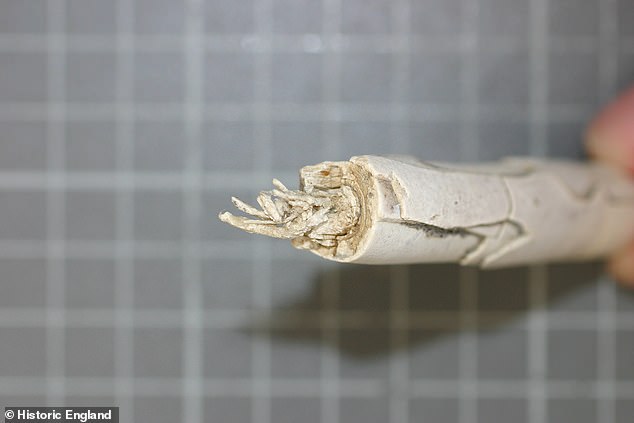
Pictured is a beeswax candle fragment from the wreckage, showing the fibrous wick in the centre

The neck and rim of a shaft and globe type glass bottle dating somewhere between 1650 and 1665, the year the ship sank
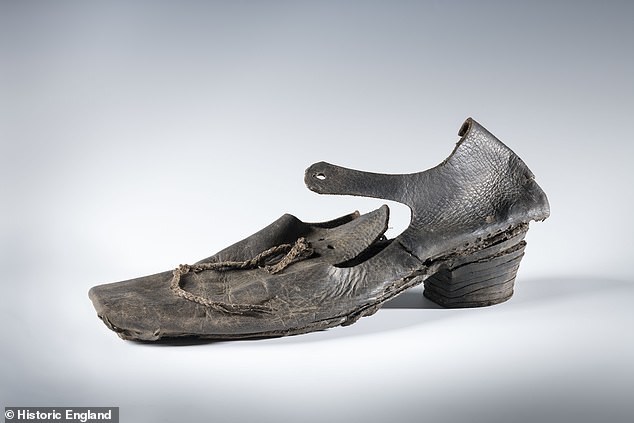
A leather shoe with lace, which likely belonged to one of the 300 souls who lost their life when the ship exploded and sank
The London is on Historic England’s Heritage at Risk Register, due to the wreck’s ongoing erosion.
Strong currents and exposure to destructive wood-boring organisms which are moving into warmer English waters pose a great risk to artefacts and the surviving ship’s structure, the charity says.
As an example, seaworms are boring into the wood of the gun carriage recovered from the wreckage.
What’s more, climate change is bringing more of these destructive wood-boring seaworms into warmer English waters.
In 2020, Historic England funded a multibeam geophysical survey of the wreck site, which revealed significant loss of sediment in some locations, further endangering the wreck.

An impressive bronze cannon recovered from The London’s wreck. The wreck was rediscovered in 2005, which caused port authorities to change the route of the shipping channel to prevent further damage
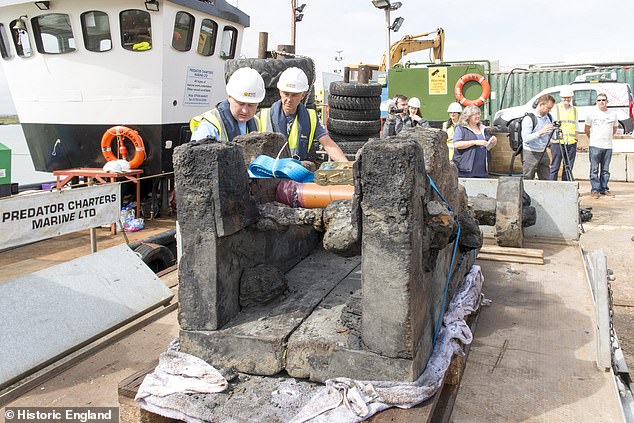
Workers with a gun carriage taken from The London’s wreckage. The rare and extremely well-preserved 350-year old wooden gun carriage was raised from the seabed in 2015
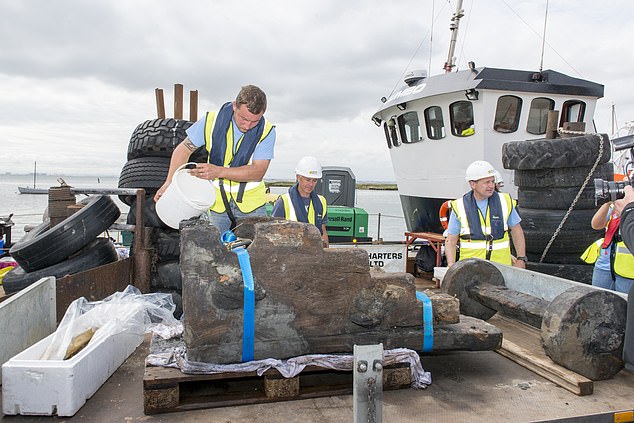
Workers with the gun carriage at Leigh-on-sea. The London was one of only three completed wooden second rate ‘large ships’ that were built between 1600 and 1642

Detailed image of the seaworms that are boring into the wood of the gun carriage. Climate change is bringing more of these destructive wood-boring seaworms into warmer English waters
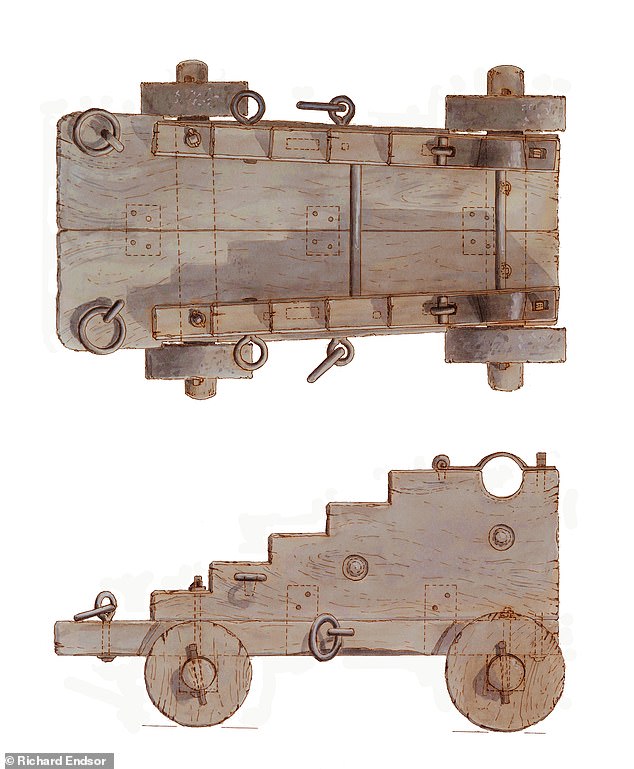
Drawing of a 17th century wooden gun carriage recovered from the protected wreck of HMS Stirling Castle, which is similar to the gun carriage discovered during excavations of The London

Axel of 350-year-old gun carriage being hoisted shore from the wreck of The London from the crane barge to quayside at Leigh-on-sea in 2015

Well-preserved coil of cannon breaching rope that’s associated with a gun carriage. The ship went down due to a mysterious spontaneous combustion and sank, killing 300 men on board
The wreck of HMS London is so significant that the Port of London Authority is moving the shipping channel to avoid disturbing it.
Since the wreck was found in 2005, it has been visited by divers several times, and sections of wood have been recovered for ongoing analysis by archaeologists.
It sank with the loss of 300 lives when it was blown up accidentally – possibly after a sailor had taken a candle too close to gunpowder barrels.
Another theory is sailors were re-using artillery cartridges so that some of the cotton inside them disintegrated into a fine dust, which when combined with tiny quantities of sulphuric and nitric acids in gunpowder formed an explosive substance.

A close-up of the scale on a copper alloy navigational instrument that was partially buried in the silt. The silted, anaerobic environment of the Thames Estuary is perfect for preserving such fine detail

A metal signet pipe tamper ring with a possible griffin figure seal. The seal could be used with wax to impress upon letters and could also be worn as a ring by its owner. The tamper end could also be used for tampering down pipe tobacco when packing the bowl of the pipe

Pictured, a small fragment of rope excavated from what remains of The London back in 2014

Wooden double pulley block ‘in remarkable condition’, according to Historic England, protected by centuries of burial in the clay and silt of the Thames Estuary
The vessel was in service when Samuel Pepys began to draw up his plans for Britain’s navy. On March 7, 1665 Pepys recorded the event in his diary.
‘…This morning is bought to me to the office the sad news of the London, in which Sir J Lawson’s men were all bringing her from Chatham to the Hope, and thence he was to go to sea in her – but a little a-this-side of the buoy of the Nower, she suddenly blew up.
‘About 24 and a woman that were in the round house and coach saved; the rest, being 300, drowned – the ship breaking all into pieces – with 80 pieces of brass ordnance. She lies sunk, with her round house above water. Sir J Lawson hath a great loss in this, of so many good chosen men, and many relations among them.’
Source link : https://www.dailymail.co.uk/sciencetech/article-9919335/Divers-making-digital-map-17th-century-warship-London.html












